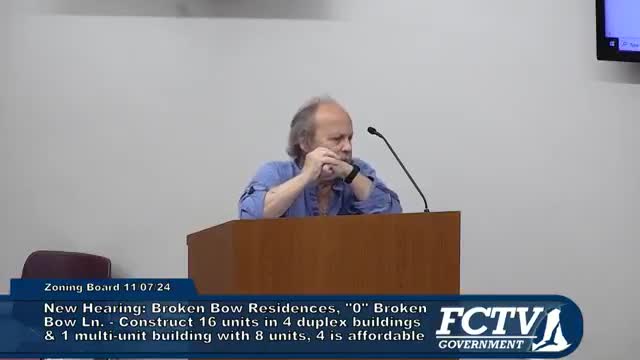Falmouth residents voice opposition to proposed 16-unit affordable housing development
November 08, 2024 | Town of Falmouth, Barnstable County, Massachusetts
This article was created by AI summarizing key points discussed. AI makes mistakes, so for full details and context, please refer to the video of the full meeting. Please report any errors so we can fix them. Report an error »

The Falmouth Zoning Board of Appeals convened on November 7, 2024, to discuss significant community concerns regarding a proposed housing development on Bridal Bow Lane. The meeting featured a series of public comments from local residents, highlighting issues related to flooding, traffic, and the overall suitability of the project for the area.
The discussion began with residents expressing alarm over existing flooding problems in the vicinity, particularly around Falmouth Harbor and Main Street. One resident recounted personal experiences with flooding, noting that prior to recent sewer installations, their property had remained dry for decades. Concerns were raised about the potential for increased flooding if the new development proceeded, with residents questioning who would bear the costs of flood insurance for affected properties.
Traffic was another major point of contention. Several speakers pointed out that the proposed development, which could add multiple housing units to a lot originally designated for a single home, would exacerbate already congested road conditions. Residents cited the presence of a nearby sober home, which has led to increased vehicle traffic and parking issues, as a contributing factor to their concerns about the new development.
Additional comments focused on the density of the proposed project, with residents arguing that placing 16 units on a single lot is inappropriate for the area. Many expressed fears that such density would lead to further parking problems and negatively impact the quality of life for existing residents. Concerns were also raised about the potential for increased noise and disturbances, particularly from the sober home across the street.
The meeting concluded with a strong consensus among residents against the proposed development, with many calling for a reconsideration of the project’s design and its impact on the community. The board acknowledged the concerns raised and indicated that further discussions and evaluations would be necessary before any decisions could be made regarding the development.
Overall, the meeting underscored the community's apprehension about the implications of increased housing density in an area already facing significant environmental and infrastructural challenges.
The discussion began with residents expressing alarm over existing flooding problems in the vicinity, particularly around Falmouth Harbor and Main Street. One resident recounted personal experiences with flooding, noting that prior to recent sewer installations, their property had remained dry for decades. Concerns were raised about the potential for increased flooding if the new development proceeded, with residents questioning who would bear the costs of flood insurance for affected properties.
Traffic was another major point of contention. Several speakers pointed out that the proposed development, which could add multiple housing units to a lot originally designated for a single home, would exacerbate already congested road conditions. Residents cited the presence of a nearby sober home, which has led to increased vehicle traffic and parking issues, as a contributing factor to their concerns about the new development.
Additional comments focused on the density of the proposed project, with residents arguing that placing 16 units on a single lot is inappropriate for the area. Many expressed fears that such density would lead to further parking problems and negatively impact the quality of life for existing residents. Concerns were also raised about the potential for increased noise and disturbances, particularly from the sober home across the street.
The meeting concluded with a strong consensus among residents against the proposed development, with many calling for a reconsideration of the project’s design and its impact on the community. The board acknowledged the concerns raised and indicated that further discussions and evaluations would be necessary before any decisions could be made regarding the development.
Overall, the meeting underscored the community's apprehension about the implications of increased housing density in an area already facing significant environmental and infrastructural challenges.
View full meeting
This article is based on a recent meeting—watch the full video and explore the complete transcript for deeper insights into the discussion.
View full meeting
